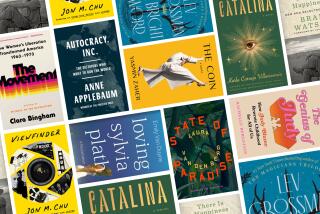<i> The Jaguar Smile by Salman Rushdie (Elisabeth Sifton/Viking: $12.95; 138 pp.) </i>
- Share via
Salman Rushdie’s brief, headlong journey through the thickets of Nicaragua’s Sandinista revolution poses the dilemma of how to tell the good guys from the others in the guise of a popular limerick:
There was a young girl from Nic’ragua
who smiled as she rode on a jaguar
they returned from the ride
with the young girl inside
and a smile on the face of the jaguar.
Are the Sandinistas the young girl or the jaguar? Rushdie, the East Indian author of two highly regarded novels, “Midnight’s Children” and “Shame,” leaves the question open, although he tilts in favor of regarding the jaguar as the United States or as “geopolitical forces,” which would devour the youthful revolution.
Rushdie admits at the outset that he did not visit Nicaragua as an impartial observer. He went there as the privileged guest of the Sandinista Cultural Workers Assn., which extended him every convenience, from a translator and chauffeured vehicle to private interviews with the top comandantes.
In one of the rhetorical lapses that mar Rushdie’s otherwise fresh and provocative view of Nicaragua, he asks himself: “Would I find myself disliking the Sandinistas? One didn’t have to like people to believe in their right not to be squashed by the U.S.; but it helped, it certainly helped.”
Since Rushdie was already a strong supporter of, if not a card-carrying convert to “ la causa ,” what makes this slim volume interesting is the quarrels he picked with the Sandinistas rather than their more predictable common ground. Rushdie’s left - of - center stand on such East-West issues as a Palestinian homeland was well known in Nicaragua.
After three weeks of consorting with comandantes and several encounters with commoner folks in outposts like Matagalpa and Bluefields, Rushdie decides that he likes most Sandinistas, but not everything they do in the name of La Revolucion. As a Third World writer who lived part of his formative years in the West, Rushdie is offended by the boring jingoism of La Barricada, the Sandinista government’s newspaper, and by the shutdown of the opposition newspaper La Prensa .
To writers from abroad, the revolution provides a mirror in which they see reflected their own passionate contradictions. Rushdie finds a successful, often brilliant voluntary exile who dislikes governments and who dissects their shortcomings from a studied, ironic distance. The Sandinistas, he tells us, head the first government he has not opposed, at least “not yet.”
Rushdie finds a good deal to like in a country run by a socialist juvenocracy of poets and intellectuals very like himself. But while he gets along comfortably with Nicaragua’s movers and shakers, he also finds kindred spirits among English-speaking Creoles and Miskito Indians who harbor legitimate grievances against the Sandinistas.
On the whole, “el escritor hindu” as he is unofficially known, comes off best in his exchanges with his peers. Vice president and novelist Sergio Ramirez and cultural minister (and famous poet) Ernesto Cardenal match Rushdie’s sparkling verbal wizardry, and they share, in their own way, his bifocal East/West perspectives. Cardenal and Ramirez, who have traveled in the Orient, got part of their education in the United States and Europe.
Ramirez leads Rushdie to his most valuable insight: The Sandinistas, he discovers, did not inherit a country but a private fiefdom run by the Somoza dynasty with U.S. backing. The nationalist passions generated by the revolution were essential to forging a Nicaraguan national identity, where in fact none had existed before. Augusto Cesar Sandino, a rebel guerrilla fighter killed by the first Somoza more than 50 years ago with the help of U.S. Marines, is Nicaragua’s George Washington in a Will Rogers wide-brimmed hat. Having no soil of their own in which to root their identity, the Nicaraguans had to invent themselves, and give birth to a nation from their own heads.
The lack of an inherited national identity or a constitutional tradition gives a context for interpreting the Sandinistas’ crass insensitivity to press censorship, and their clumsy mishandling of the Miskito Indians. But it does not excuse them.
Toward the end of his sojourn, Rushdie comes back to the question: Is the revolution the tiger or the lady who gets devoured? Although his sympathies are clear, he gives no firm answer.
By way of accommodation, he ends with a quote from a distressed pro-Sandinista passenger Rushdie meets on the flight out, a woman whose mother has died of negligence in a Nicaraguan hospital. The woman accuses the Sandinistas of committing many errors but concludes, “The revolution has to exist, or there is no hope.”
Rushdie’s own clinging to hope enables him to close his ironic distance, and to continue to support the Sandinistas in spite of themselves.
More to Read
Sign up for our Book Club newsletter
Get the latest news, events and more from the Los Angeles Times Book Club, and help us get L.A. reading and talking.
You may occasionally receive promotional content from the Los Angeles Times.







